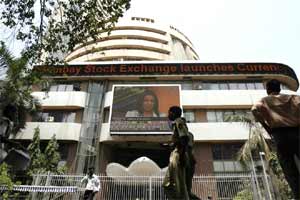Indian stock markets roared into rally mode on Monday, reversing an eight-session long losing streak with benchmark indices clocking in gains of 517.22 points or nearly 2%. On a day when the Chinese market touched a seven-year high, soaring 2.6%, that took its year-to-date gains to 16.9%, Indian benchmarks too found support after a month-long correction.
Since March 4, when the Sensex scaled the 30,000-mark intra-day, the barometer had corrected 2,136 points, or 7%, as of last Friday. With Monday’s gain, the Indian benchmarks are set to end the fiscal 2014-15 on a strong note with an annual gain of 25%; indeed, FY15 is set to be the best year for equity market returns in the last five years.
However, at $18 billion purchases of Indian shares by foreign investors is moderate compared with their buying activity in FY13 of $25.8 billion and FY11 when they bought $24.2 billion worth of stocks.
Foreign institutional investors (FIIs) own nearly 28% of the Sensex and close to 23% of India’s market-capitalisation of R101. 26 lakh crore ($1.6 trillion).
In a broad-based rally on Monday, the 30-share Sensex added 517.22 points to close at 27,975.86 while the broader Nifty gained 150.9 points to end the session at 8,492.3.
Although corporate earnings have been subdued and demand conditions in the economy remain weak, the turn in the interest rate cycle and the government’s success with reforms is encouraging investors given crude oil prices remain relatively low. However, the fact that there’s a consensus overweight rating on India has in itself raised concerns.
Bank of America Merrill Lynch (BofAML) believes the market will be range -bound to negative over the next few months. According to the brokerage house, a common refrain from companies is that nothing has really changed on the ground in the 10 months post-election. “This highlights our near term concern that the pace of economic recovery as well as earnings recovery will disappoint investors near term,” BofAML noted in a recent report.
While India continues to be a preferred long-term investment destination, concerns over the US Fed’s interest rate stance have triggered a pull-back in the market. Market observers feel that these concerns could continue to weigh on the market in the near-term, especially as earnings are yet to recover.
“The expectations of a Fed rate hike are slowly getting built into the price. The Fed rate hike will impact Indian market because flows in the emerging funds could slow down and India has enjoyed the biggest allocation. While the average allocation in the MSCI is 7-8%, most funds have allocated 20% to 25% towards India. We may see another three to six months of subdued movement because eventually earnings need to catch up with the expectations,” observed Rashesh Shah, chairman & CEO, Edelweiss Group.
While earnings for the October-December quarter earnings came in below expectations, the commentary from corporate India had a cautious tone, leading to several earnings downgrade. Bloomberg data shows, that the consensus Sensex EPS (earnings per share ) estimates for fiscal 2015-16 came down from Rs 1,905 to Rs 1,793 in the last three months.
On Monday, while the BSE mid-cap index mirrored the gains of largecap indices as it gained 2%, the small-cap index added 3.4%.The banking space and capital goods stocks lead the market with stocks like HDFC, Axis Bank and L&T rallying between 3% to 3.5%. The Reserve Bank of India on Monday said that banks could set aside upto 50% of the floating provisions towards provisions for non-performing assets up, from the earlier 33%.
